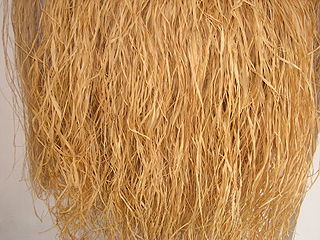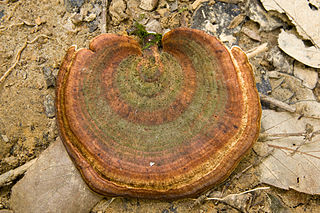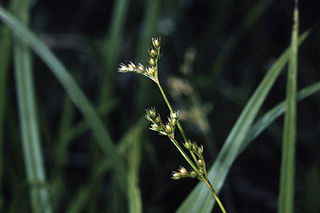
In ecology, an oasis is a fertile area of a desert or semi-desert environment that sustains plant life and provides habitat for animals. Surface water and land may be present, or water may only be accessible from wells or underground channels created by humans. In geography, an oasis may be a current or past rest stop on a transportation route, or less-than-verdant location that nonetheless provides access to underground water through deep wells created and maintained by humans.

The Arecaceae is a family of perennial, flowering plants in the monocot order Arecales. Their growth form can be climbers, shrubs, tree-like and stemless plants, all commonly known as palms. Those having a tree-like form are called palm trees. Currently, 181 genera with around 2,600 species are known, most of which are restricted to tropical and subtropical climates. Most palms are distinguished by their large, compound, evergreen leaves, known as fronds, arranged at the top of an unbranched stem. However, palms exhibit an enormous diversity in physical characteristics and inhabit nearly every type of habitat within their range, from rainforests to deserts.

Rattan, also spelled ratan, is the name for roughly 600 species of Old World climbing palms belonging to subfamily Calamoideae. The greatest diversity of rattan palm species and genera are in the closed-canopy old-growth tropical forests of Southeast Asia, though they can also be found in other parts of tropical Asia and Africa. Most rattan palms are ecologically considered lianas due to their climbing habits, unlike other palm species. A few species also have tree-like or shrub-like habits.

The flowering plant genus Ipheion belongs to Allioideae, a subfamily of the family Amaryllidaceae. The World Checklist of Selected Plant Families no longer recognize the genus, regarding it as a synonym of Tristagma, although The Plant List accepts two species.

The genus Pritchardia consists of between 24 and 40 species of fan palms found on tropical Pacific Ocean islands in Fiji, Samoa, Tonga, Tuamotus, and most diversely in Hawaii. The generic name honors William Thomas Pritchard (1829-1907), a British consul at Fiji.

Pandanus is a genus of monocots with some 578 accepted species. They are palm-like, dioecious trees and shrubs native to the Old World tropics and subtropics. The greatest number of species are found in Madagascar and Malaysia. Common names include pandan, screw palm and screw pine. They are classified in the order Pandanales, family Pandanaceae.

Mauritia flexuosa, known as the moriche palm, ité palm, ita, buriti, muriti, miriti (Brazil), canangucho (Colombia), morete (Ecuador), or aguaje (Peru), is a palm tree. It grows in and near swamps and other wet areas in tropical South America.

Attalea maripa, commonly called maripa palm is a palm native to tropical South America and Trinidad and Tobago. It grows up 35 m (115 ft) tall and can have leaves or fronds 10–12 m (33–39 ft) long. This plant has a yellow edible fruit which is oblong ovoid and cream. An edible oil can be extracted from the pulp of the fruit and from the kernel of the seed.

Carl Ernst Otto Kuntze was a German botanist.

Banksia littoralis, commonly known as the swamp banksia, swamp oak, river banksia or seaside banksia and the western swamp banksia, is a species of tree that is endemic to the south-west of Western Australia. The Noongar peoples know the plant as pungura, boongura or gwangia. It has rough, crumbly bark, linear, more or less serrated leaves arranged in whorls, yellow flowers and up to two hundred follicles in each head.

Raphia vinifera, the West African piassava palm, bamboo palm or West African bass fibre is a palm tree species in the genus Raphia. It is native to Benin, Gambia, Ghana, Nigeria, Togo, Central African Republic, Cameroon, Ghana, and Democratic Republic of the Congo. It is particularly abundant along the creeks of Niger Delta, Cross River, Lagos and Ikorodu in Nigeria.

Rinorea is a genus of plant in family Violaceae.

Microporus is a genus of fungi in the family Polyporaceae. The genus has a widespread distribution and, according to a 2008 estimate, contains 11 species. The genus name combines the Ancient Greek words μικρός ("small") and πόρος ("pore").
Gymnopogon (skeletongrass) is a genus of American and Southeast Asian plants in the grass family.

Calamoideae is a subfamily of flowering plant in the palm family found throughout Central America, South America, Africa, India, China, Southeast Asia and Australia. It is represented by 21 genera - containing nearly a quarter of all species in the palm family - including the largest genus, Calamus, the type genus of the group. Only four are found in the New World while the rest are Old World denizens, usually found in equatorial swampland or along tropical coastlines.

Napoleonaea imperialis is a small, evergreen tropical West African tree in the family Lecythidaceae, native to Africa.
Climbing palms are genera in the family Arecaceae that grow as lianas. "Initially erect, the slender stems seek out trees for support and climb up into the forest canopy by means of recurved hooks and spines growing on the stem, leaves and inflorescences. In all climbing palms the leaves are pinnate and grow along the stem instead of forming a dense crown. The stems of climbing palms, more often referred to as canes, are solid in contrast to bamboo poles which are almost always hollow." "The majority of climbing palms are also clumping palms [and sympodial], sending out new shoots from [below ground as suckers]." "About 600 species of palms in [16] genera have a climbing growth habit. Most noteworthy is the genus Calamus--the largest genus in the palm family with approximately 350 described species--source of nearly all commercial rattan."
Lepistemon is a genus of flowering plants belonging to the family Convolvulaceae.

Juncus secundus, the lopsided rush, one-sided rush, or second rush, is a species of flowering plant in the family Juncaceae, native to eastern North America and introduced to Primorsky Krai in Russia. It is typically found in serpentine, granite, and other barrens.
















